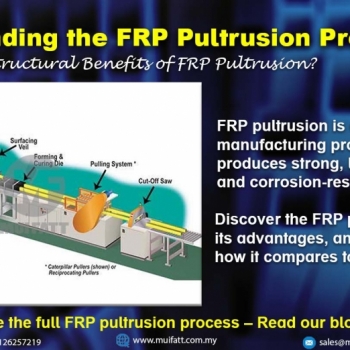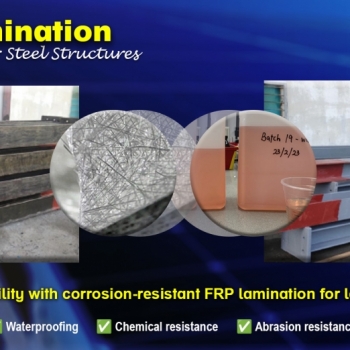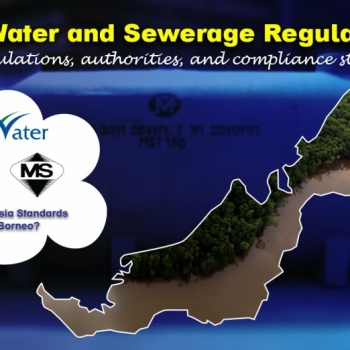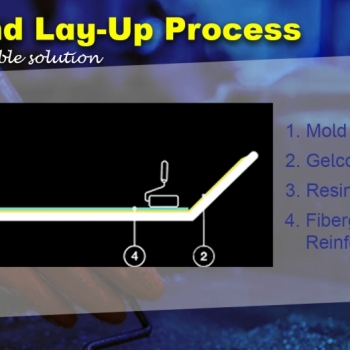FRP pultrusion is a continuous manufacturing process that produces strong, lightweight, and corrosion-resistant profiles. This article explains how the process works, its advantages, and how it compares to other FRP fabrication techniques, helping you choose the right material for your project.
The Costly Mistake of Using Unsuitable Resin for FRP Tanks
14 Jan 2025
How Incorrect Resin Selection Damaged an FRP Wastewater Tank
- Key Takeaways
- The Importance of Resin Selection in FRP Wastewater Tanks
- Real-Life Case: GP Resin Failure in an FRP Wastewater Tank
- Why Specialized Resins Are Essential for Caustic Wastewater
- Steps to Prevent Resin Failures in FRP Tanks
- Conclusion: Choosing the Right Resin for Safety and Longevity
- Frequently Asked Questions (FAQs)
- Why is resin selection crucial for FRP tanks?
- Can GP resin be used for any wastewater tank?
- What are the risks of using GP resin in chemical tanks?
- What are the most suitable resins for wastewater tanks containing caustic soda?
- How can I prevent resin-related tank failures, such as peeling and bubbling in FRP tanks?
- What are the signs of resin failure in FRP tanks?
- Can high temperatures affect resin performance in FRP tanks?
- What is the role of expert consultation in selecting resins for FRP applications?
- Are all resins certified for industrial use?
Key Takeaways
- Choosing the right resin for FRP wastewater tanks is important to prevent operational problems, particularly in chemically aggressive environments. Determining the chemical composition of the wastewater is key.
- GP resin is effective in normal applications, but fails under high-pH or high-temperature conditions. Specialized resins, such as vinyl ester, provide the best chemical resistance and durability.
- Liquid caustic soda (NaOH) in wastewater can corrode steel and concrete materials and damage tank integrity. Specialty resins are more equipped to handle the elements and the test of time.
- A real-life failure of GP resin in an FRP tank highlights the importance of proper resin selection. It further urges the need to consider chemical compatibility.
- Work alongside resin specialists to help arm yourself with useful knowledge. Implement more robust and comprehensive material testing to avoid failures, increase the lifespan of tanks, and save money over time.
- Regular maintenance and monitoring are critical to detecting early signs of resin degradation, such as peeling or bubbling, and ensuring long-term tank performance.
When it comes to fabricating FRP (Fiberglass Reinforced Plastic) wastewater tanks, one crucial factor can make or break their performance: the choice of resin, it has a significant impact on the long-term performance and durability of FRP (Fiberglass Reinforced Plastic) wastewater tank. Using unsuitable resin can lead to severe structural failures, including internal corrosion, peeling layers, and even tank leaks. Choosing the right resin will perform best in the physical examination where it's being used. In this article, we’ll share a real-life case study highlighting these risks and discuss best practices for preventing similar problems.
The Importance of Resin Selection in FRP Wastewater Tanks
As discussed earlier, the choice of resin has a significant impact on the long-term performance and durability of FRP (Fiberglass Reinforced Plastic) wastewater tanks. Material selection cannot be just about picking one off the shelf. Let's explore why this decision is so important.
Improper Resin Choices Can Lead to Problems
When the incorrect resin is selected, the long-term performance of the tank can be impacted in drastic ways. For example, low-grade resins may not resist the attack of aggressive chemicals, resulting in crumbling or leakage over time.
These problems not only interrupt operations but can run up a tab that costs a fortune in repairs or replacements. For instance, selecting a general-purpose (GP) resin for a tank that will be processing corrosive wastewater. If the tank does not have adequate resistance, it could start to break down prematurely, threatening the entire system.
The Impact of Chemical Exposure on Resin Integrity
Wastewater is a unique environment because it often contains strong chemicals that can quickly degrade the resin. For one, acids or alkalis within the water can go after the resin’s bonds, making it weak.
Over time, this can lead to brittleness, warpage, or even complete structural failure. The chemical exposure does not end at the surface—it can permeate the material, further jeopardizing its structural integrity.
That’s why tanks used in industrial wastewater systems require a resin with high chemical resistance.
Common Resins Used in FRP Fabrication
|
Resin Type |
Key Features |
Typical Applications |
Limitations |
|---|---|---|---|
|
General-Purpose (GP) |
Affordable, easy to use |
Low-cost tanks, basic applications |
Limited chemical and thermal resistance |
|
Orthophthalic Resin |
Improved durability, moderate cost |
Domestic water tanks, mild chemicals |
Not suitable for aggressive environments |
|
Vinyl Ester Resin |
High chemical and thermal resistance |
Industrial tanks, harsh chemicals |
Higher cost than GP and orthophthalic |
GP resins work well in typical applications such as storage tanks for non-corrosive liquids. Orthophthalic resins, on the other hand, offer a high level of durability, making them ideal for use in moderate environments.
When it comes to industrial tanks that must resist aggressive chemicals, vinyl ester resin is usually the preferred option. Its increased cost is countered by its proven resilience in adverse conditions.
Challenges of Wastewater Containing NaOH
-
The Corrosive Nature of Caustic Soda - Sodium hydroxide (NaOH), or caustic soda, is used for its corrosive properties. It has the potential to break down more fragile resins over time, risking leaks or structural failure.
-
Temperature Variations and Resin Performance - Especially in the case of industrial wastewater which may be variable in temperature, increasing the stress placed on the resin even further. For example, NaOH solutions at elevated temperatures may speed degradation.
-
Chemical Reactions and Tank Integrity - NaOH could react with other components of the wastewater, forming byproducts that might have their own corrosive attack on the tank material.
-
The Importance of Chemical Resistance - In environments that include NaOH, chemical resistance becomes a matter of life and death. Resins that are not resistant to this property can lead to premature failure, operational downtime and safety hazards.
Real-Life Case: GP Resin Failure in an FRP Wastewater Tank
Initial Fabrication and Customer Request
A customer approached us with a customized design. They required a durable FRP (Fiberglass Reinforced Plastic) tank for their industrial wastewater treatment. They wanted it to be produced in General Purpose (GP) resin, assuming that would be sufficient. At first glance, this sounded like a good thing, but there was a major catch. Unfortunately, the customer was not forthcoming with the complete chemistry of the wastewater. For instance, their omission of caustic soda (NaOH) led to unintended consequences.
The Case of NaOH-Containing Wastewater
Caustic Soda, abbreviated as NaOH, is a strong alkali that is a key input in many industries. Its highly caustic nature makes it difficult to mitigate, particularly when combined with materials that are not built to withstand it. We know that NaOH can degrade general-purpose resins over time, particularly on contact with elevated temperatures.
In this instance, the wastewater held NaOH levels that varied from weak to very alkaline. Additionally, the tank operated in temperature ranges over 60°C adding to the complexity of the situation. GP resin, while adaptable, does not have the chemical resistance needed for these caustic environments.
Specialized resins are specially formulated to resist aggressive materials such as NaOH. By failing to select one of these, the tank’s long-term durability was compromised from the outset. Knowing the implications of how chemicals might react with resin formulations is imperative. It affects both the initial bond strength as well as the long-term compatibility of the materials.
Failure Analysis: What Went Wrong?
Three months after installation, the client reported significant issues:
-
Internal Corrosion: The tank walls showed clear signs of chemical reactions with NaOH.
-
Peeling Layers: The GP resin internal layer began peeling off.
-
Bubbling on the Wall Surface: The chemical reaction caused delamination, weakening the structure.
-
Leaking Tank: Structural compromises led to leaks, posing operational risks.
The following factors made GP resin unsuitable in this case:
-
High Alkalinity (NaOH): GP and Orthophthalic resins have low resistance to caustic soda, making Vinyl Ester a far better alternative.
-
Elevated Operating Temperatures: Increased heat amplifies chemical reactivity, breaking down less-resistant resins.
-
Continuous Exposure: Prolonged contact with NaOH caused internal degradation, peeling, loss of mechanical properties, and discoloration of the resin matrix.
This real-life example highlights the need for selecting appropriate materials for service conditions and the need for periodic inspections to identify issues before they become critical.
Why Specialized Resins Are Essential for Caustic Wastewater
When it comes to caustic wastewater, the stressors our materials are subjected to and thus, materials selected for storage and processing systems must be robust. Specialized resins, such as vinyl ester resins, are more effective than GP resins in these harsh conditions. Here’s why specialized resins are so critical.
Superior Chemical Resistance of Vinyl Ester Resins
Vinyl ester resins are specifically made to handle tough chemicals, making them ideal for treating caustic soda (NaOH) wastewater. While GP resins can work in milder chemical settings, they often break down too quickly in strong caustic conditions. In wastewater treatment treatment plants (WWTPs) dealing with solutions that have a pH higher than 12, tanks made from GP resin can develop blisters, and eventually, cracks may form.
On the other hand, vinyl ester resins are specially designed to endure extreme caustic substances, maintaining their strength even in harsh environments. This leads to less need for repairs and a longer lifespan, which is essential in industries where exposure to caustic materials is common. Their greater longevity and reduced maintenance requirements render them a more cost-effective option in the long run.
Recommendations for Handling High-Temperature, High-pH Wastewater
Caustic wastewater isn’t just chemically aggressive—it’s often hot, as well. Temperatures in industrial storage tanks can be as high as 60°C or higher, taking materials to their extremes.
With extended exposure to heat, GP resins can begin to soften, causing the structure to become compromised. Specialty resins, like vinyl esters for example, are engineered for extreme thermal stability.
This unique formulation prevents them from chipping or cracking, even in extreme high-temperature environments. They continue to be a smart, proven, and dependable solution for industries like power plants or chemical manufacturing. In these sectors, wastewater streams are often hot.
Steps to Prevent Resin Failures in FRP Tanks
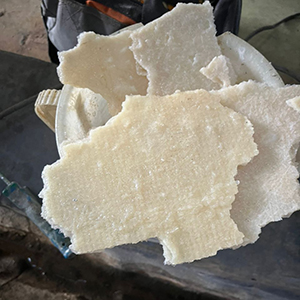 Consulting Experts on Resin Types
Consulting Experts on Resin Types
Resin manufacturers can be valuable partners to help you select the best product for your needs. Their experience makes a difference to selecting pre-accelerated or unaccelerated resin.
They come to this conclusion according to particular requirements such as cure time and method of application.
Testing and Validation for Specialized Applications
Testing procedures such as tensile strength and chemical resistance tests ensure that resin has performed. Customized testing for specialty applications, like high temperature environments, make sure that the resin is right for the job.
Conclusion: Choosing the Right Resin for Safety and Longevity
Choosing the right resin for safety and longevity is crucial in various applications, whether in crafting, construction, or industrial uses. The type of resin selected can significantly impact the durability and safety of the final product.
Different resins have unique properties, such as UV resistance, flexibility, and chemical stability. Understanding these properties helps in making an informed decision based on the specific needs of the project.
Investing in high-quality resin can save time and resources in the long run by reducing the need for repairs or replacements. Ultimately, the right choice of resin will enhance the safety and durability of the finished product, ensuring satisfaction and reliability for years to come.
At Mui Fatt, we combine technical expertise with rigorous quality control to manufacture highly durable FRP tanks. By selecting the right resin and reinforcing materials, we ensure:
-
Chemical compatibility with wastewater contents.
-
Longevity under demanding operating conditions.
-
Customization options for specific industrial requirements.
Talk to us now via WhatsApp or email at sales@muifatt.com.my for customizable wastewater tanks!
Frequently Asked Questions (FAQs)
Why is resin selection crucial for FRP tanks?
The resin binds the fiberglass and determines the chemical resistance, strength, and durability of the tank. Using the wrong resin can lead to failures like corrosion and peeling.
Can GP resin be used for any wastewater tank?
GP resin is suitable only for environments with low chemical exposure and moderate conditions.
What are the risks of using GP resin in chemical tank?
GP resin lacks chemical resistance and may lead to peeling, bubbling, and leaks under harsh conditions.
What are the most suitable resins for wastewater tanks containing caustic soda?
Vinyl ester resin is ideal for high-alkalinity conditions, offering superior chemical and thermal resistance.
How can I prevent resin-related tank failures, such as peeling and bubbling in FRP tanks?
Consult with material experts, select appropriate resins, and ensure quality fabrication practices.
What are the signs of resin failure in FRP tanks?
Signs of resin failure usually mean peeling, bubbling, and cracked tops. If any signs of failure are seen, consult an expert right away to minimize and address the damage.
Can high temperatures affect resin performance in FRP tanks?
Resins can be compromised by high temperatures, particularly if those resins weren’t engineered to be heat-resistant. Higher temperatures accelerate chemical reactions that degrade unsuitable resins, causing structural failures.
What is the role of expert consultation in selecting resins for FRP applications?
When you work with an experienced expert, you’ll find the best option resin to fit your specific requirements. Professionals are always learning about new materials and industry standards, preventing you from making costly errors.
Working with engineering experts and manufacturers helps provide the best materials suited for the application, laying the foundation for long-term success.
Are all resins certified for industrial use?
Not all resins are tested or certified. Always choose certified materials for guaranteed performance.
#frpwastewatertanks #resinfailure #gpresincorrosion #corrosioninfrptanks #gpresinvsvinylester #frptankfabrication #naohwastewater #orthophthalicresinissues #tankpeeling #frpfabricationtips #frptanks #chemicalresistance #wastewatersolutions
Disclaimer:-
The content on this site is for general information and entertainment purposes and does not constitute legal counsel. We strive to keep our information as accurate as possible. However, we make no warranties about the completeness, accuracy, reliability, suitability, or availability with respect to the information contained on this page. You should rely on this information at your own risk. This website may include links to other third-party sites. These links are provided as a convenience to you as a reader, user, or browser only. We make no representation, warranty, or guarantee, nor do we endorse or take responsibility for any of the content of such sites.
Stay in touch with us if you’re interested in hearing from us promptly.
- Website - https://www.muifatt.com.my/home/
- Facebook - https://www.facebook.com/muifattmarketing
- Instagram - https://www.instagram.com/muifattmarketing/
- Google - https://goo.gl/maps/WxVY13gNcaRTS7Jp6
- Youtube - http://www.youtube.com/@MuiFattMarketing
- TikTok - https://www.tiktok.com/@muifattmarketing
- LinkedIn - https://www.linkedin.com/company/mui-fatt-marketing-sdn-bhd-
- Linktree - https://linktr.ee/muifattmarketing
- Shopee - https://www.shopee.com.my/muifattmarketing
- Lazada - https://www.lazada.com.my/shop/mui-fatt-marketing
Recent Blog
The Ultimate Guide to Locking Mechanisms for FRP Molded Grating
Understanding the right locking method for FRP molded grating is crucial for safety and durability. Learn about M clips, J clips, C clips, and disk plates, along with installation recommendations to ensure a secure and stable grating system.
Enhancing Solar Panel Fixing Structures with FRP Lamination: A Corrosion Barrier Solution
An expert look at how FRP lamination acts as a corrosion barrier for solar panel fixing structures, offering advanced protection and sustainability benefits.
Steel Fixing Structures in Solar Panel Installations: Corrosion Challenges and Alternative Materials
An in-depth look at the corrosion challenges faced by steel solar panel fixing structures and alternative materials that offer enhanced durability and sustainability.
The Essential Guide to Kickplates: Safety, Style & Compliance
Learn why kickplates matter for safety, style, and compliance. Discover how they improve accessibility and meet building code requirements.
Essential Guidelines for Water & Septic Tanks in Borneo
Understand the regulations and guidelines for water and septic tanks in Borneo, plus compliance with SPAN, IWK, and SIRIM standards in Malaysia.
Mastering the FRP Hand Lay-Up Process: Methods, Benefits, Sustainability
Discover the FRP hand lay-up manufacturing process, its importance, differences from other methods, and how it aligns with your custom project needs.
Transform DIY Projects with FRP Pultruded Profiles
Explore the versatility of FRP pultruded profiles and how they can elevate your DIY landscaping projects. Get inspired by Mui Fatt's successful applications and learn how to create custom solutions for small- to larger-scale projects.



